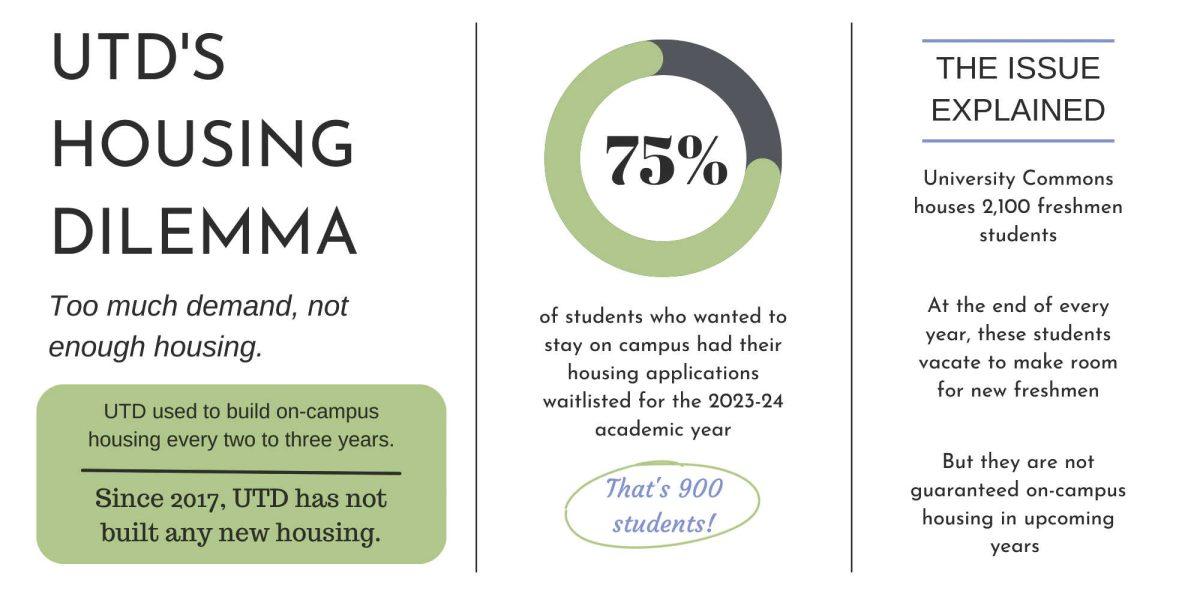The housing market is already difficult for millions of North Texans, but as summer approaches and enrollment continues to increase, UTD has little availability for on-campus housing.
University Housing announced on March 28 that there were no more spaces available to non-first-year residents for the 2023-24 academic year. As the waitlist reached over 900 names, University Housing was prompted to close the annual non-first-year application period.
“Due to the considerable waitlist for fall housing … the new resident application for non-first-year students is temporarily delayed,” the statement read.
As UTD sheds its commuter school designation, housing fills up quickly, leaving Comets with fewer on-campus options.
“It’s certainly difficult to find things close to campus,” Griffin Davis, a computer science graduate student and student government senator, said. “There are houses and some residential single-family areas across from campus, but many of those … are very expensive, and the apartments are a little bit further away.”
Matthew Grief, an associate vice president for student affairs, said that the number of housing renewals indicated that this year’s availability would be different.
“[The] numbers were higher this year than they had been in the past, and that’s the first step of our housing process,” Grief said.
About 1,274 students wanted to stay on campus next year or renew their current location, creating a substantial waitlist, according to Grief.
The five residence halls in University Commons are exclusive to first years and house about 2,100 students. Currently, 2,248 beds have been set aside for them, but school policy maintains that after the first year, students must vacate those areas to make room for incoming freshmen.
“It’s typically the case on most college campuses when you’re here in your first year, you’re connected [with] the residence hall space, you’re around other individuals who [are] maybe in your major,” Grief said. “[They’re] gonna get more involved and become connected to the campus more if they’re on campus that first year.”
Iowa State University, for example, found that first-year students who lived on campus had a 34% higher retention rate, a 38% four-year graduation rate and a 5% higher GPA. However, UTD’s prioritization of freshmen has created competition for upperclassmen.
Current University Housing residents have to go through two processes to get a spot. First, if they live in University Village or Canyon Creek Heights, they can renew to stay in the same room for the summer and the following academic year, according to UTD. Comets who did not fill out a renewal application in time can go through sign-up, which consists of a sign-up stage, roommate group registration and roommate self-selection.
Grief said that students who go through the sign-up process are automatically put on the housing waitlist. If spaces become available, housing offers will go out to students based on their priority number, Grief said.
The highest level goes to National Merit and McDermott scholarship recipients, who are assigned numbers 1 – 499, respectively. Below that are “current University Commons residents,” between 500 and 3,500. The next four descending levels are sophomores through graduate students.
“People want to live on campus, [and] we’re really happy about that,” Grief said. “But it’s also challenging too because we don’t really have the space available to meet everybody’s needs.”
Davis, who is also a member of the advocacy group Comets For Better Transit, said the university had a role in the increased demand for housing.
“This didn’t just happen,” Davis said. “[UTD] is advertising and marketing and trying to expand enrollment.”
The administration needs to be able to support that hike in numbers with the proper infrastructure, he said. This was a concern for Davis, who noted a “Campus Master Plan” which projected UTD to be at an enrollment of 35,000 by 2030. Davis pointed out that UTD had built new residential housing consistently every two to four years but stopped in 2017 with the unveiling of Canyon Creek Heights and its 800 new beds.
“Of course, enrollment has continued to grow throughout all that time,” Davis said.
The school’s housing plan did recommend redeveloping phases 4 – 9 of student housing, but Davis fears some of that might be going toward academic buildings. He advises the school to replace phases 1 – 3 with higher-density housing.
“I commend on the work they’ve done,” Davis said. “I just implore them to continue to build more housing space.”





